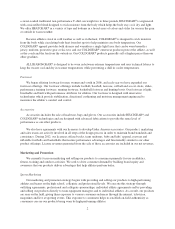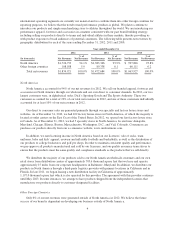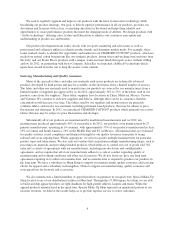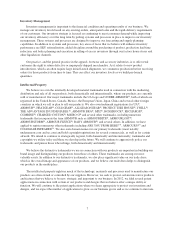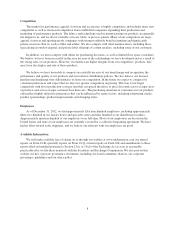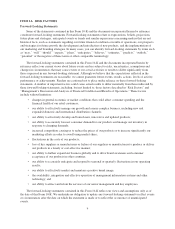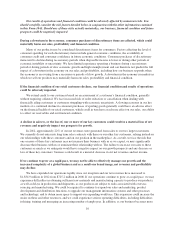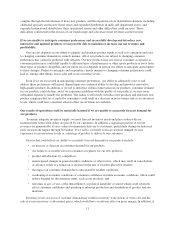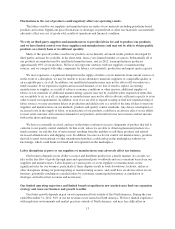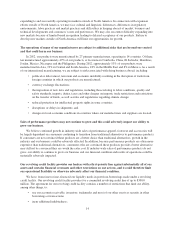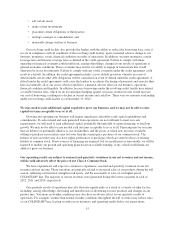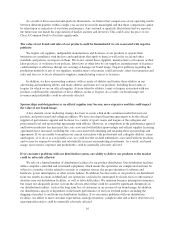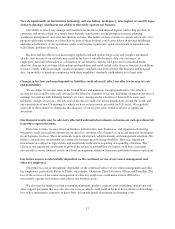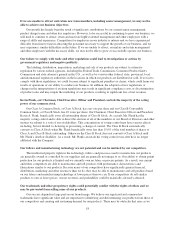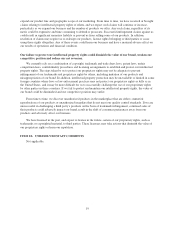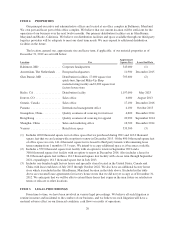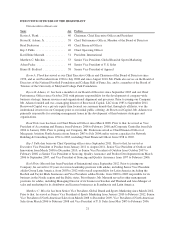Under Armour 2012 Annual Report Download - page 19
Download and view the complete annual report
Please find page 19 of the 2012 Under Armour annual report below. You can navigate through the pages in the report by either clicking on the pages listed below, or by using the keyword search tool below to find specific information within the annual report.complex through the introduction of more new products and the expansion of our distribution channels, including
additional specialty and factory house stores and expanded distribution in malls and department stores, and
expanded international distribution, these operational strains and other difficulties could increase. These
difficulties could result in the erosion of our brand image and a decrease in net revenues and net income.
If we are unable to anticipate consumer preferences and successfully develop and introduce new,
innovative and updated products, we may not be able to maintain or increase our net revenues and
profitability.
Our success depends on our ability to identify and originate product trends as well as to anticipate and react
to changing consumer demands in a timely manner. All of our products are subject to changing consumer
preferences that cannot be predicted with certainty. Our new products may not receive consumer acceptance as
consumer preferences could shift rapidly to different types of performance or other sports products or away from
these types of products altogether, and our future success depends in part on our ability to anticipate and respond
to these changes. Failure to anticipate and respond in a timely manner to changing consumer preferences could
lead to, among other things, lower sales and excess inventory levels.
Even if we are successful in anticipating consumer preferences, our ability to adequately react to and
address those preferences will in part depend upon our continued ability to develop and introduce innovative,
high-quality products. In addition, if we fail to introduce technical innovation in our products, consumer demand
for our products could decline, and if we experience problems with the quality of our products, we may incur
substantial expense to remedy the problems. The failure to effectively introduce new products and enter into new
product categories that are accepted by consumers could result in a decrease in net revenues and excess inventory
levels, which could have a material adverse effect on our financial condition.
Our results of operations could be materially harmed if we are unable to accurately forecast demand for
our products.
To ensure adequate inventory supply, we must forecast inventory needs and place orders with our
manufacturers before firm orders are placed by our customers. In addition, a significant portion of our net
revenues are generated by at-once orders for immediate delivery to customers, particularly during our historical
peak season from August through November. If we fail to accurately forecast customer demand we may
experience excess inventory levels or a shortage of product to deliver to our customers.
Factors that could affect our ability to accurately forecast demand for our products include:
• an increase or decrease in consumer demand for our products;
• our failure to accurately forecast consumer acceptance for our new products;
• product introductions by competitors;
• unanticipated changes in general market conditions or other factors, which may result in cancellations
of advance orders or a reduction or increase in the rate of reorders placed by retailers;
• the impact on consumer demand due to unseasonable weather conditions;
• weakening of economic conditions or consumer confidence in future economic conditions, which could
reduce demand for discretionary items, such as our products; and
• terrorism or acts of war, or the threat thereof, or political instability or unrest which could adversely
affect consumer confidence and spending or interrupt production and distribution of product and raw
materials.
Inventory levels in excess of customer demand may result in inventory write-downs or write-offs and the
sale of excess inventory at discounted prices, which would have an adverse effect on gross margin. In addition, if
11



